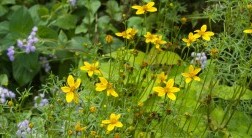Many gardeners feel compelled to prune back perennials and grasses in the fall, and some plants do indeed need to be cleaned up. But those with beautiful and interesting ornamental elements can help your garden make the transition from autumn to winter. Seed heads, pods, and flower heads add subtle colors as well as architectural form—and can provide vital food for wildlife. So don't be so hasty to get rid of these dried treasures, especially if you prefer a naturalistic and less controlled planting.

- Echinops ritro 'Veitch's Blue' (globe thistle)
Clump-forming perennial with spiny, dissected leaves that are green above and white underneath. Dark blue globe-shaped flowers bloom from July to September.
Zones 3 to 8. - Baptisia sphaerocarpa (yellow wild indigo)
Upright perennial with spikes of yellow blooms borne in May and June above bluish-green trifoliate foliage. Rounded tan seedpods turn brown when ripe. South-central and eastern U.S. native.
Zones 5 to 8. - Nigella damascena 'Miss Jekyll Blue' (love-in-a-mist)
Unusual heirloom annual with sky-blue flowers in June surrounded by delicate fernlike bracts that form the "mist." Flowers are followed by decorative burgundy seedpods. Treat as an annual in the Northeast. - Calamagrostis x acutiflora 'Karl Foerster' (feather reed grass)
Stately cool-season deep green grass that sways gracefully in the lightest breeze and provides a vertical accent in any garden. Feathery pink inflorescences appear in June and mature into a golden tan color that lasts through winter.
Zones 5 to 9. - Sedum 'Matrona' (sedum)
Clump-forming perennial with pale pink umbels from August to October atop burgundy stems and gray-green succulent leaves. Flower heads turn a russet tan color in winter.
Zones 3 to 9.
- Salvia 'Indigo Spires' (sage)
Tender perennial that bears dark purple flowers on arching stems all summer until frost. Treat as an annual in the Northeast.
Zones 8 to 11. - Eryngium x 'Sapphire Blue' (sea holly)
Short-lived clump-forming perennial with steel-blue conelike flowers surrounded by bracts of the same blue from June to August. Heart-shaped spiny leaves and stems are also tinged with blue.
Zones 5 to 9. - Asclepias tuberosa (butterfly weed)
Clump-forming perennial with bright orange to yellow-orange florets from June to August, followed by lance-shaped seedpods, which split open to release fluffy seeds. Important nectar and food source for butterflies. Eastern U.S. native.
Zones 3 to 9. - Echinacea tennesseensis (Tennessee coneflower)
Perennial coneflower with upturned rose-purple petals that blooms from June until August atop narrow green foliage. Bristly copper cone lasts through winter. Endangered Tennessee native. Prefers part shade.
Zones 5 to 6. - Achillea 'Coronation Gold' (yarrow)
Upright, clump-forming perennial with aromatic silvery to gray-green fernlike foliage and long-lasting flattened yellow flower heads that bloom from June to September.
Zones 3 to 8. - Helictotrichon sempervirens 'Sapphire Fountain' (blue oat grass)
Finely textured semievergreen cool-season grass with brilliant steel-blue foliage and tall, arching, bluish-brown flower spikelets in June, which turn into golden oatlike seed heads in autumn.
Zones 4 to 8.



